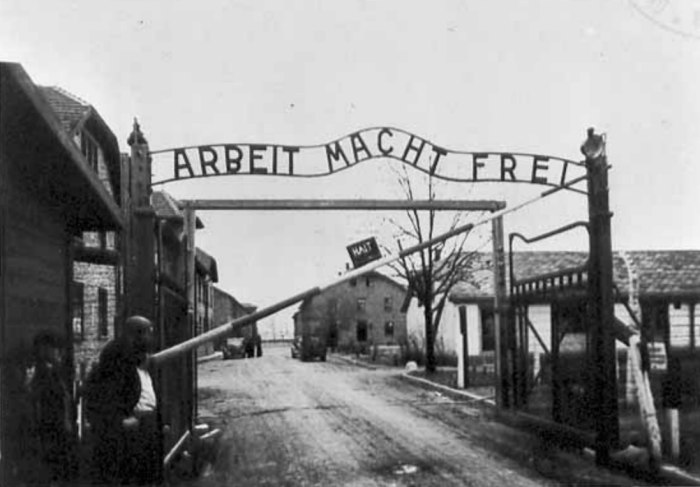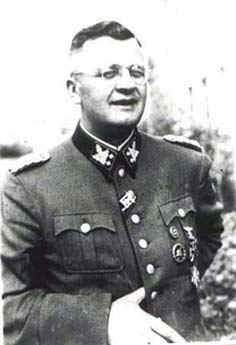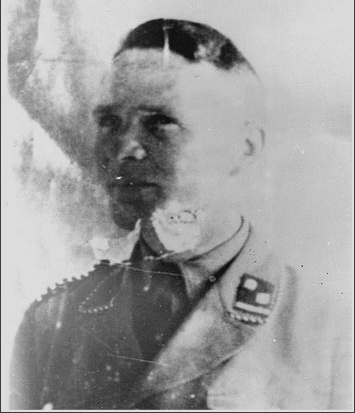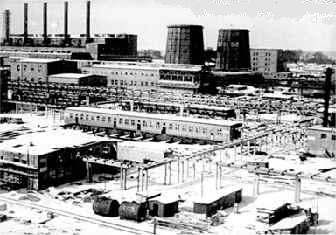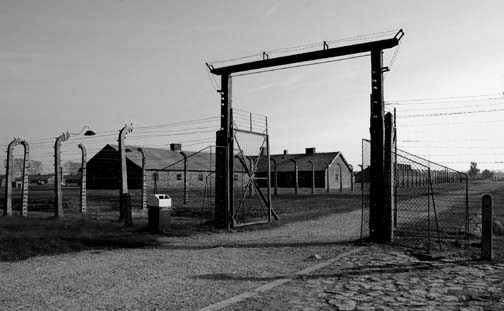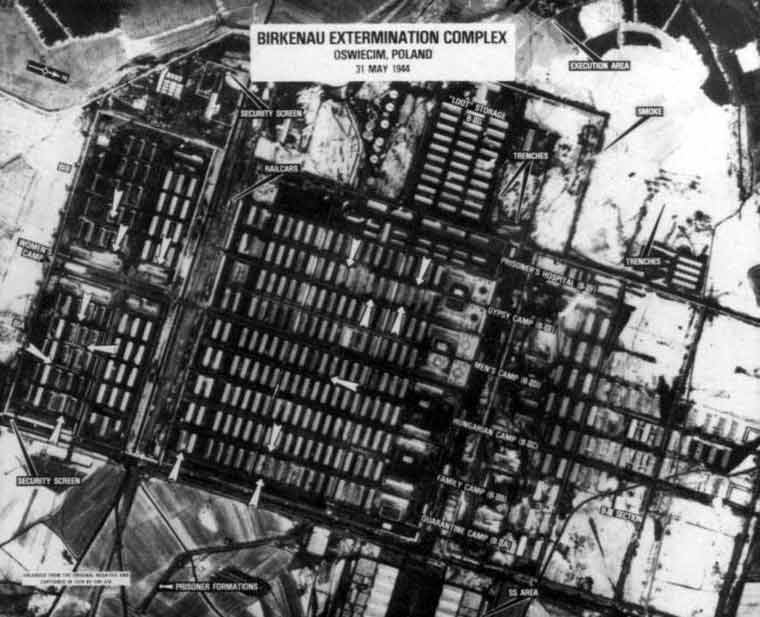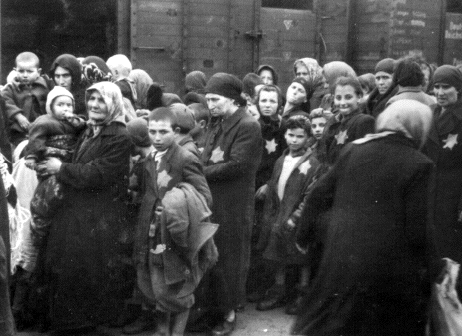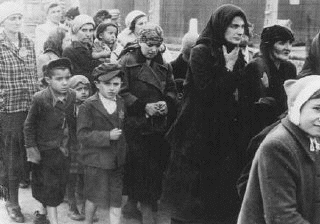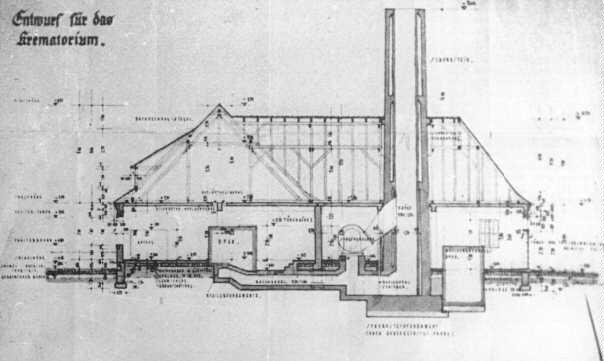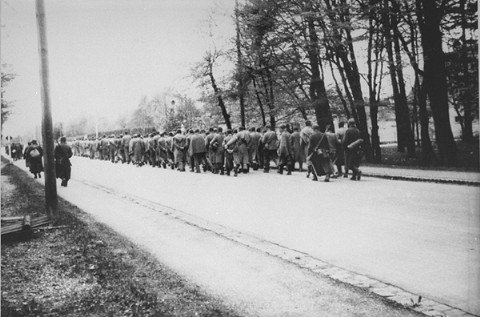Holocaust Education & Archive Research Team |
|
Other Camps
Key Nazi personalities in the Camp System The Labor & Extermination Camps
Auschwitz/Birkenau Jasenovac Klooga Majdanek Plaszow The Labor Camps
Trawniki
Concentration Camps
Transit Camps
|
|||||||||
Auschwitz Concentration Camp The Historical Outline
The project of establishing a concentration camp at Oswiecim or as it had been named when within the Habsburg Empire, Auschwitz, originated in Breslau (Wroclaw) in the office of the Higher SS and Police Leader for the southeast, SS –Gruppenführer Erich von dem Bach-Zelewski.
His subordinate, the Inspector of the Security Police and Security Services, SS – Oberführer Arpad Wigand submitted such a proposal at the end of 1939, prompted by reports of the overcrowding of the prisons of Upper Silesia and the Dabrowa Basin, which impeded the security police in its task of carrying out terroristic and repressive measures against the Polish population. Justifying this proposal SS-Oberführer Wigand stressed that the resistance movement in Silesia and the General–Government was intensifying, which meant that mass arrests were necessary and that the existing concentration camps were inadequate for holding all of those who were to be arrested. Wigand pointed to Auschwitz as a suitable place for a concentration camp. He considered that the existing barracks there could immediately be used for holding prisoners. Also, barracks outside the town in the fork of the Vistula and Sola rivers, in the region called Zasole, would make a future expansion of the camp possible and ensure its isolation from the outside world. A further argument in favour of its proposed siting was the convenient railway connections with Silesia, the General-Government, Czechoslovakia and Austria. In the first days of January 1940, the Inspector of Concentration Camps, SS-Oberführer Richard Glücks sent a commission headed by SS-Sturmbannführer Walter Eisfeld, the camp commandant of Sachenhausen concentration camp, to Auschwitz. In the commission’s opinion the barracks at this site were not suitable for conversion into a concentration camp. This opinion was not shared by the Higher SS and Police Leader Bach-Zelewski, and he wrote to SS Head Office stating that a camp would be established at Auschwitz. On 1 February 1940, with a view to taking a final decision concerning the site of the planned camp, Reichsführer – SS Himmler ordered that inspections be made of the police prison at Welzheim, the transit camp at Kislau, the camp at Frauenberg, the camp at Sosnowiec and the proposed camp at Auschwitz. On 21 February 1940 SS-Oberführer Glücks informed Himmler that after the installation of certain sanitary amenities and the carrying out of certain structural alterations, the former Polish artillery barracks at Auschwitz would be suitable for a quarantine camp. Negotiations would have to take place between the chief of the security police and the Wehrmacht regarding the handing over of the barracks. As a result of these negotiations, on 8 April 1940, Air Force General Halm gave his consent to the renting out of the barracks and the drawing up of a contract concerning their transfer to the SS. In connection with the finalisation of the negotiations between the Wehrmacht and the SS, on 18-19 April 1940, another commission went to Auschwitz headed by SS- Hauptsturmführer Rudolf Höss, who had succeeded Eisfeld at Sachenhausen concentration camp. After Höss had submitted his report to Glücks, Himmler gave the order for the establishment of a concentration camp at Auschwitz; the existing buildings were to be expanded by prisoner labour.
Having been sent to Auschwitz again by Glücks, Höss arrived there accompanied by five SS men on 30 April 1940 to carry out the preliminary work. On 4 May 1940 he was officially appointed commandant of concentration camp Auschwitz. Höss remained commandant until November 1943, when he was succeeded by SS-Obersturmführer Artur Liebehenschel, who retained the post until May 1944, when he in turn was succeeded by SS-Sturmbannführer Richard Baer, who served in this post till the end of the camp’s existence. In order to prepare the site of the future camp, Höss acquired 300 local Jews from the mayor of Auschwitz. They worked at the camp throughout the whole of May and up to the middle of June, along with a dozen or so local Polish workers. On 20 May 1940 Rapportführer Gerhard Palitzsch brought 30 prisoners to Auschwitz, convicted criminals of German nationality, selected at Höss’ request from among the prisoners at Sachenhausen. These prisoners were given serial numbers 1-30 and placed in Block 1 of the camp. They were intended to act as trusties, constituting an extension of SS control and exercising immediate and cruel supervision over the prisoners in the camp. At the same time, 15 SS men from the SS cavalry detachment in Krakow were sent to Auschwitz as members of the future garrison. On 29 May 1940, a group of prisoners known as an `outside squad’ under the supervision of Unterscharführer Beck was sent to Auschwitz from Dachau concentration camp. The squad consisted of one German prisoner, the kapo and 39 Polish prisoners, mainly senior secondary school pupils from Lodz. The squad brought a wagonload of barbed wire and began to erect a fence around the future camp. The prisoners were accommodated in the cookhouse of the former barracks and employed in building the first provisional fence around the camp. They were led daily across the barracks square beyond the barracks from the direction of the road leading from Auschwitz to Rajsko. There they wound the barbed wire around wooden posts. On 14 June 1940 the first transport of Polish political prisoners, numbering 728 men, arrived in Auschwitz from the prison in Tarnow, sent by the SIPO and SD commander in Krakow. The prisoners were given the serial numbers 31- 758 and placed in quarantine in the building of the former Polish Tobacco Monopoly, which was situated near the railway siding and separated from the other buildings by a barbed wire fence. At the same time, the staff was strengthened by the dispatch of a further 100 SS men plus officers and NCOs. Among the SS men appointed were Josef Kramer of adjutant, Karl Fritzsch, and Maximillian Grabner as head of the political department. There then followed a series of forced evacuations of Poles who lived in the vicinity of the camp; in Zasole the houses and their contents were taken over by SS men who served at the camp and their families. The territory thus depopulated, about 40 square kilometres in area, was called the camp’s `zone of interest’ (Interessengebit). The zone constituted the land lying in the fork of the Vistula and Sola rivers, within boundaries running from Broszkowice along the Sola to the village of Bielany, thence through Leki Skidzin, Wilczkowice, by Brzeszcze, to the Vistula, and thereafter along the course of the river to the mouth of the Sola near Broszkowice. The above mentioned area was constantly patrolled by the SS and the local Gestapo and police. At the moment of its founding, the concentration camp at Auschwitz contained twenty brick buildings, of which fourteen were single and six were two-storied. Between 20 May 1940 and 1 March 1941, 10,900 persons, mostly Poles, were imprisoned in the camp.
Heinrich Himmler, Reichsführer –SS, came to Auschwitz for the first time on 1 March 1941.He was accompanied by the Gauleiter und Oberprasident of Upper Silesia, Fritz Bracht, the Wroclaw HSSPF, Ernst Schumauser, SS-Oberführer Glücks, and leading personalities of the IG Farben concern. After a thorough inspection of the camp and the surrounding terrain, Himmler ordered Höss to undertake the following:
Himmler also indicated that large armament plants should be built near the camp, as well as a settlement for SS men.
The first sketch of a general plan for the expansion of the main camp at Auschwitz was ready in broad outline by June 1941. The area envisaged for expansion was bounded in the south by the Auschwitz- Rajsko road running along the river Sola and stretched northward as far as the railway tracks leading from Auschwitz to Jawiszowice. The general plan of expansion envisaged the creation of four sectors. In the first western sector there was planned a housing estate for the SS with lawns, a sports pitch and a riding school. The second was to contain the camp headquarters and the economic–industrial area of the camp; the third, bordering on the headquarters and economic-industrial area, was to contain the concentration camp proper. The fourth, bordering the camp on the east, was to contain the barracks for the SS garrison.
For the camp itself an area 1,000 metres long and 400 metres wide was marked out. The buildings intended for the prisoners were to form two complexes divided by a square. The first section was made up of the existing brick buildings of the main camp, to which it was intended to add extensions. This complex was to contain 33 blocks for prisoners; following the demolition of warehouses and workshops between the two complexes, it was planned to have a large Appellplatz in the space thus created. The two complexes combined were to have a total of 78 single-storey buildings to accommodate prisoners. Work on the extension of the camp commenced in the summer of 1941, with the use of prisoner labour and building materials derived from the demolished houses in the Zasole district. The erection of eight single–storey buildings commenced on the Appellplatz; the addition of another storey to fourteen of the existing single-storey buildings was started, and a camp kitchen was built. Beyond the wire an administrative building for the SS was erected. The location of the IG Farben plant at Dwory, near Auschwitz, was dictated by three considerations; firstly, the need to secure it against bombing; secondly, the accessibility of coal mines in the vicinity; and thirdly, the proximity to Auschwitz with its enormous labour force. In April 1941 prisoners from Auschwitz began work on the construction of the Buna-Werke at Dwory. At first the prisoners covered the first seven kilometres to the site on foot and then travelled the remaining distance by train. They were often very late arriving for work as military transports had priority. The difficulties connected with transporting the prisoners to work and the consequent fall in productivity moved the IG Farben concern to build a separate camp for the prisoners near the Buna-Werke in the evacuated village of Monowitz (Auschwitz III). From the end of October 1942 the prisoners were accommodated here. In spring 1941 a number of prisoner squads were set up for work in the fields, harvesting the crops the local farmers had planted before their forced evacuation. Next, a start was made on the establishment of large farms, and in February 1942 SS-Obersturmbannführer Joachim Caesar arrived in Auschwitz to take up the post of director of farms at the camp. During the years 1941–43, large farms for the raising of crops and stockbreeding were organised in the evacuated and razed villages and hamlets in the camp’s zone of interest. In Rajsko an experimental plant station was set up, where research was mainly devoted to raising the kok-saghyz plant, the root of which contains a rubber - yielding substance. On the farms, either huts were built or existing buildings were adapted for the accommodation of male and female prisoners, thus giving rise to branch camps in Babice, Budy, Harmeze, Plawy and Rajsko. The existing workshops in the camp were also expanded in the course of 1941, as well as the SS enterprise Deutsche Ausrustgswerke (DAW), which at a later stage received orders to carry out repair work for the army. The building of the camp at Brzezinka, (German: Birkenau – Auschwitz II) was begun in October 1941. The SS proceeded to demolish the farm buildings at Brzezinka and assemble the materials necessary for the future camp. For this work they used prisoners and POWs who had to be driven daily to the Brzezinka camp. To direct the work of construction, SS-Sturmbannführer Karl Bischoff was seconded from Amstgruppe C of the WVHA in Berlin. The plan of the POW camp dated 14 October 1941 was confirmed by Bischoff, and the following day signed off by commandant Höss. According to this plan the area of the camp was to be divided into two parts by a main road. Beside the road a railway siding was planned. To the left of the main road and siding there was to be a quarantine camp, and to the right two camps, numbered (l) and (ll).
The entire area of the new camp formed a compact rectangle surrounded by barbed wire fences and guarded by watchtowers. The sides of the rectangle were to measure 720 by 1,130 metres. According to the plan, the three Birkenau camps were to contain a total of 174 brick-walled prison huts, each intended to house 744 inmates. Originally, each hut had been designed to hold 550 prisoners, but by increasing the number of occupants of the 62 bays into which each hut was divided from three to four, Bischoff increased the capacity of the camp to 129,456 persons. The space available for a prisoner in one of the three “roosts” into which each bay was itself divided was equivalent to the dimensions of a large coffin, or the volume of a shallow grave. Work began with the levelling and draining of the marshy terrain; next the POWs and inmates were employed on the building of a road from the bridge over the railway track to the gateway of the future camp, the extraction of sand from the gravel pit, the unloading of materials and at laying the foundations of the new huts. To complete this frantic work of building and expansion, between March 1941 and February 1942, about 18,000 inmates and Soviet POWs lost their lives. On 26 March 1942 the newly created women’s section of KL Auschwitz received 999 German women prisoners from KL Ravensbrück and 999 Jewish women brought from Pored in Slovakia. The women were given the numbers 1-1988. The first Polish women political prisoners, 127 in number, arrived on 27 April 1942 from Montelupich prison in Krakow and Tarnow prison. They received the serial numbers 6784 – 6910. On 17–18 July 1942 Himmler visited Auschwitz for the second time, accompanied by Bracht, Schumauser, and Heinz Kammler, who was in charge of construction for the concentration camps, army, SS and police and armaments industry. Visits were made to the farms, the experimental plant station, the laboratories, land improvement works and the camp at Birkenau (where Himmler witnessed a mass gassing), Buna-Werke, and the main camp (Stammlager). Following his inspection, Himmler ordered Höss to speed up the expansion of the camp at Birkenau, to liquidate the Jewish prisoners incapable of work, and to build armaments factories. The extermination of the Jews at Birkenau had begun in January 1942. During his visit in July 1942 Himmler observed the entire process. He was present as the Jews were unloaded from the train, as the selection was made, at the gassing in the bunker and the removal of the corpses afterwards. In the autumn of 1941 the mortuary of Auschwitz I was converted into a gas chamber and this small facility was used until July 1943. The first transports of several hundred Jews were sent from Upper Silesia by the Katowice Gestapo. The people were killed with Zyklon B gas (hydrocyanic acid) in the morgue of the crematorium. Participants in these killing operations were SS captain Hans Aumeier, roll-call leader Gerhard Palitzsch, the director of the political department, Maximilian Grabner, and the gas specialist Adolf Theuer. Two additional gas chambers were built in Birkenau using converted farmhouses, as selected by Adolf Eichmann. The first was known as the Red House, (or Bunker Number I) because of its red brick structure. On 20 March 1942 the first transport to be gassed there came from Upper Silesia. The Jews were taken from the unloading platform at the freight depot in Auschwitz directly to the gas chambers. Here they were gassed with Zyklon B crystals. The gas was introduced through specially constructed openings. The corpses of the murdered people were buried in mass graves in a nearby meadow. After each operation the prisoners involved in the burial were killed in the prisoner’s infirmary with a phenol injection into the heart, administered by Josef Klehr. In connection with the plans for additional transports of Jews to Auschwitz, in June 1942 more gas chambers were built in a farmhouse similar to Bunker Number I. It was located west of the later site of Crematoria IV and V and was known as the White House or Bunker Number 2. Next to it three barracks were built to serve as undressing rooms for the Jews prior to their gassing. The Jews were taken from the unloading platform at the freight depot in Auschwitz directly to the gas chambers. Here they were gassed by Zyklon B crystals. The gas was introduced through specially constructed openings.
The corpses of the murdered people are buried in mass graves in a nearby meadow. After each operation the prisoners used in the burial are killed in the prisoners infirmary with a phenol injection into the heart, administered by Josef Klehr.
In June 1942 in connection with the plans for additional transports of Jews to Auschwitz more gas chambers were built in a farmhouse similar to Bunker Number I. It was located west of the later site of Crematorium IV and V and is known as the White House or Bunker Number 2. Next to it three barracks are built to serve as undressing rooms for the Jews prior to gassing. Jews were transported to Auschwitz from all over occupied Europe, the pace of murder reaching its climax in the summer of 1944, when more than 400,000 Jews were deported from Hungary, over a period of two months. Most of the deportees, especially the sick, the elderly and the children, were selected on the ramp by SS Doctors for extermination. One of the most important documents of the destruction of the Hungarian Jews, was the photograph album “Auschwitz Album” by Lili Jacob. This photograph album of the “resettlement” of the Hungarian Jews, was produced by the SS for propaganda purposes, and was found at the end of the war by Lili Jacob, who recognised members of her family, and thus realised it was a record of her own transport. The photos show the arrival of a transport at Birkenau from the Berehovo ghetto, in the upper Ruthenian Carpathians, possibly on 27–28 May 1944. It was from Berehovo that rabbi Hugo Gryn was deported with his family to Birkenau later that summer.
With Himmler’s plan for the wholesale extermination of the Jews in Auschwitz, the mass murder and body disposal issues needed to be resolved. Thus the next plan, dated 15 August 1942, envisaged the building at Birkenau of a complex of camps for 200,000 POWs, as well as extermination installations. Of the previous plan there remained only construction sector 1 with camps Bla and Blb. On the right of the main road and railway siding it was planned to have construction sector ll later to be known to the prisoners as “Mexico” (BIII). Construction sector lV was to be located to the left of construction sector l – thus the order of sectors from left to right was BlV, Bl, Bll, Blll. Sector lV was envisaged to hold 60,000 persons, sector l 20,000 persons and sectors ll and lll 60,000 prisoners each. Each construction sector, with the exception of the already completed sector Bl, was to be divided into six separate parts or camps, partitioned from one another by barbed wire and with individual entrance gates. At each gate there was to be an SS guard room. The living quarters for the prisoners were to be contained within a regular rectangle measuring 720 by 2,340 metres. It was planned to build two crematoria within two rectangular areas jutting out from the western side of the camp, along the extension of the main road and the tracks of the railway siding. In the event, four crematoria were built together with gas chambers. It was planned to build a further crematorium but time ran out before the plan could be realised. In advance of the plan being drawn up in August, the Central Construction Board of the Waffen –SS and Police in Auschwitz had begun negotiations with various firms concerning the construction of not two, but four large crematoria and gas chambers. An offer accompanied by an estimate of 133,756.65 Reichsmarks for the building of one crematorium was lodged on 13 July by the firm Hoch-und Tiefbau A.G. of Katowice. The building of the crematorium ovens and the installation of the necessary equipment in the gas chambers was undertaken by the firm of J.A. Topf und Sohne of Erfurt. Both the Central Construction Board and the civil construction firms hired inmate labour from the camp command, and the rate of construction was very rapid. Between March and June 1943 the building of four enormous crematoria together with gas chambers was completed at Birkenau. During the course of 1943, construction sector ll was completed; it contained six camps plus a section where the plundered personal effects of Jews condemned to extermination were stored. In Camp Bllb, a family camp was set up for Jews from the ghetto town of Theresienstadt (Terezin) in Bohemia. On 9 September 1943 5,006 and on 16 and 20 December a further 4,964 men, women, and children were transported to Camp BIIb from Theresienstadt. By March 1944, 1,100 persons from the September transport had died of hunger, disease and as a result of the poor sanitary conditions; on 9 March 1944, 3,791 men, women and children from the same transport were gassed. Only about 75 persons were spared – physicians and twins. Camp doctor SS-Hauptsturmführer Josef Mengele conducted pseudo-medical experiments on the latter. Between 16-19 May 1944 7,449 inmates from Terezin arrived at the family camp in three successive transports. This brought the camp BIIb complement up to about 11,000 prisoners. In the first days of July 1944, after a selection conducted by Mengele, 3,080 young and healthy men and women were transferred to other concentration camps. The family camp was then liquidated with the gassing on 11-12 July of the same year of the estimated 7,000 men, women and children who remained.
In December 1943 more installations were built in construction sector ll. Between gas chamber/crematorium lll and gas chamber/crematorium IV, a delousing station and bath-house called the `sauna’ and a warehouse camp for personal effects were installed. The Effektenlager, known as `Canada ll’, comprised 30 huts wherein all of the belongings of those condemned to extermination were temporarily stored before being inspected, sorted, packed and dispatched to various Nazi establishments. Gold, objects of value, precious stones and currency were sent to the WVHA and thence to the Reichsbank. The huts were permanently filled to overflowing, and heaps of unsorted baggage rose up between them. In this camp the SS employed over 2,000 prisoners of both sexes. In mid-May 1944 the Central Construction Board completed the railway siding and unloading ramp in Birkenau. The siding was situated adjacent to the main camp road between the sectors. Inside the camp the siding consisted of three tracks. In June 1944, in Camp Bllc and on the territory of the as yet uncompleted construction sector Blll, known to the prisoners as `Mexico’, a transit camp for Jewish women, chiefly from Hungary was organised. Between 11 August and 4 October 1944, 10,000 Polish, Russian and Czech prisoners were transported from Auschwitz to the concentration camps at Buchenwald, Sachsenhausen and Flossenbürg. Within a similar timeframe, 3,824 prisoners from the men’s quarantine camp at Birkenau alone were gassed. In October 1944 the expansion of the main camp at Auschwitz was halted, as was work on the development of Sector Blll at Birkenau. No attempt was made to start work on construction sector BlV, but instead steps were taken to evacuate the warehouses containing building materials. The entry of Soviet troops into the Lublin region, the liberation of the concentration camp at Majdanek on 24 July 1944, and the capture in that camp of several members of the SS staff forced the SS to take action to obliterate all traces and destroy the evidence of the crimes committed in Auschwitz, where countless victims had been murdered. At the end of July 1944, the political department (camp Gestapo) had already started to burn the registers containing the names of people who had been sent to their deaths in the Auschwitz gas chambers. Other departments of the camp administration also set about destroying files, registers and other camp documents.
Having learnt that the SS planned to liquidate them in the near future, members of the Sonderkommando revolted on 7 October 1944. At the midday break, the Sonderkommando in Crematorium IV were in conference discussing the revolt, when an informer surprised them; the informer was killed on the spot. After attacking the SS men with hammers, axes and stones, the Sonderkommando set Crematorium IV on fire, and tried to escape from the camp. Some of the squad did in fact reach the small wooded area nearby. At the same time, the Sonderkommando who worked in Crematorium ll rose up. They overpowered the head kapo and an SS man, who they push into the burning crematorium oven. They beat a second SS man to death, destroyed the fence that surrounded the crematorium area and escaped to the woods. With a single exception, all of those who took part in the revolt were subsequently recaptured and killed. In the final evacuation of the camp the sole survivor of the revolt was transported to KL Ebensee, where he died of starvation. In mid-October 1944 work was begun on the demolition of Crematorium IV, which had been destroyed by the Sonderkommando during the revolt.
In November 1944 the gassings were halted and Reichsführer-SS Himmler ordered the destruction of the crematoria. Throughout November and December the technical installations of the gas chambers and the ovens of Crematorium II and III were dismantled for transportation to Gross Rosen concentration camp. Special squads of men and women prisoners were created to clean out, fill in and overlay with turf the pits where corpses had been burnt or where the ashes from the crematoria had been buried. The dismantling of the huts in Camp BIII (`Mexico’) was begun and the dismantled parts were also sent to Gross Rosen. The warehouses containing the personal effects of Jews who had perished were hastily emptied and their contents dispatched by train to the Reich. The final roll call was held in Auschwitz on 17 January 1945 for 67012 inmates, this included the main camp at Auschwitz, Birkenau Monowitz and its sub-camps. On 18 January 1945 in the main camp the last serial number was issued - 202,499; the recipient was a German criminal transferred from KL Mauthausen. In itself, the number was of no significance, since several series of numbers had been used during the camps’ existence. It has been estimated that more than 400,000 prisoners were registered at KL Auschwitz. The much greater number of victims gassed on arrival at the camp never appeared on any register. On the same day the general evacuation of those fit and healthy marched out of Auschwitz and its sub-camps. Approximately 58,000 set out on a series of ‘Death Marches’. For example, 3,000 prisoners left Birkenau on 18 January 1945;only 280 of them reached their destination, Geppersdorf, in March 1945. On 27 January 1945 Auschwitz Concentration Camp was liberated by the 60th Army of the 1st Ukrainian front. . They found 7,000 sick and exhausted prisoners in the Auschwitz, Birkenau, and Monowitz camps. The precise number of victims of Auschwitz is impossible to determine, but recent research indicates that the total number of victims was 1.1 million of whom 90% were Jews.
Sources:
Auschwitz – Nazi Extermination Camp, Interpress Publishers Warsaw 1985 Auschwitz Chronicle by Danuta Czech, Henry Holt and Co New York 1989 The Atlas of the Holocaust by Sir Martin Gilbert, Michael Joseph Ltd London 1982 The Auschwitz Album – Yad Vashem & Auschwitz- Birkenau State Museum 2002 Auschwitz 1270 – To the Present by Robert Jan van Pelt and Deborah Dwork – Yale University Press New Haven and London. 1996
Copyright SJ H.E.A.R.T 2007
|
